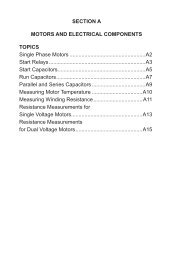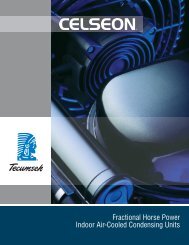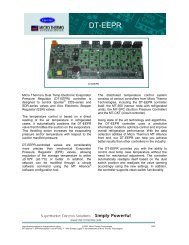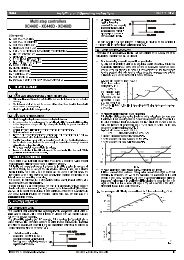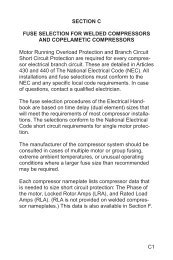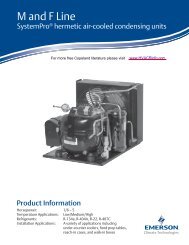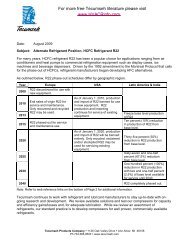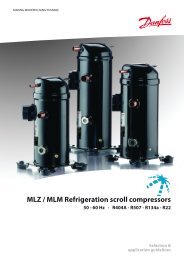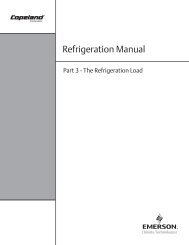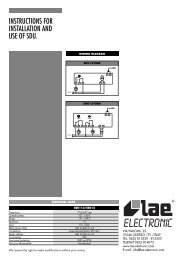Refrigeration Manual - HVAC and Refrigeration Information Links
Refrigeration Manual - HVAC and Refrigeration Information Links
Refrigeration Manual - HVAC and Refrigeration Information Links
Create successful ePaper yourself
Turn your PDF publications into a flip-book with our unique Google optimized e-Paper software.
Section 10STARTING EQUIPMENT AND MOTOR PROTECTORSSince hermetic motors must operate under a wide rangeof operating conditions, <strong>and</strong> vary in size from fractionalhorsepower to 35 HP <strong>and</strong> larger, a wide variety of startingequipment is used.CONTACTORS AND STARTERSA contactor is a load current carrying device, which makes<strong>and</strong> breaks to start <strong>and</strong> stop the compressor motor. Astarter is merely a contactor with motor protective devicesmounted in a common enclosure.On single phase motors up to 3 HP in size, the motorcurrent is often low enough to be h<strong>and</strong>led by the contactsin the low pressure control or thermostat, <strong>and</strong> no separatecontactor is required. As the motor size increases, theamperage draw increases beyond the range of smallcontrol apparatus, <strong>and</strong> the motor current must be h<strong>and</strong>ledthrough the contacts of a starter or contactor, while thecontrol makes <strong>and</strong> breaks a pilot circuit which energizesthe coil of the contactor .For motor-compressors whose power requirementsare such that contactors are required, it is essentialthat the contactors used are adequately sized for theattached load. The rating of the contactor for both fullload amperes <strong>and</strong> locked rotor amperes must be greaterthan the nameplate rating of the motor-compressor plusthe nameplate rating of any fans or other accessoriesalso operated through the contactor .NEMA general purpose type contactors are built for themost severe industrial usage, <strong>and</strong> are designed for aminimum life of 2,000,000 cycles. Because they mustbe adaptable to any usage, general purpose contactorshave a large safety factor, <strong>and</strong> as a result are bothlarge <strong>and</strong> costly. For refrigeration <strong>and</strong> air conditioningapplications, a life of 250,000 cycles is entirely adequate,so the physical construction can be lighter, <strong>and</strong> the costof the contactor correspondingly less.To meet the specific needs of the refrigeration <strong>and</strong> airconditioning industry, electrical equipment manufacturershave developed definite purpose contactors. Thesecontactors are rated in amperes, <strong>and</strong> when selectedproperly for the load, are smaller <strong>and</strong> more economicalthan the general purpose contactor. Since compressorcontactors are frequently subjected to quick recycling,the contacts must be large enough for satisfactory heatdissipation in order to prevent contactor overheating.Overheating of the contacts may cause sticking <strong>and</strong>single phasing, <strong>and</strong> can cause a motor failure eventhough the motor overload protectors trip <strong>and</strong> open thecontrol circuit.In order to insure that definite purpose contactorsare properly applied to Copel<strong>and</strong>® br<strong>and</strong> motorcompressorswith pilot circuit protection, the contactormust meet Emerson Climate Technologies, Inc. minimumperformance requirements.CAPACITORSAn electrical capacitor is a device which stores electricalenergy. They are used in electric motors primarily todisplace the phase of the current passing through thestart winding. While a detailed study of electrical theoryis beyond the scope of this manual, capacitors in amotor circuit provide starting torque, improve runningcharacteristics <strong>and</strong> efficiency, <strong>and</strong> improve the powerfactor.The amount of electrical energy a capacitor will holddepends on the voltage applied. If the voltage isincreased, the amount of electrical energy stored in thecapacitor is increased. The capacity of a capacitor isexpressed in microfarads (MFD) <strong>and</strong> is dependent onthe size <strong>and</strong> construction of the capacitor.The voltage rating of a capacitor indicates the nominalvoltage at which it is designed to operate. Use of acapacitor at voltages below its rating will do no harm. Runcapacitors must not be subjected to voltages exceeding110% of the nominal rating, <strong>and</strong> start capacitors must notbe subjected to voltages exceeding 130% of the nominalrating. The voltage to which a capacitor is subjected is notline voltage, but is a much higher potential (often calledelectromotive force or back EMF) which is generatedin the start winding. On a typical 230 volt motor, thegenerated voltage may be as high as 450 volts, <strong>and</strong>is determined by the start winding characteristics, thecompressor speed, <strong>and</strong> the applied voltage.Capacitors, either start or run, can be connected eitherin series or parallel to provide the desired characteristicsif the voltage <strong>and</strong> MFD are properly selected. When twocapacitors having the same MFD rating are connectedin series, the resulting total capacitance will be one halfthe rated capacitance of a single capacitor. The formulafor determining capacitance (MFD) when capacitors areconnected in series is as follows:© 1967 Emerson Climate Technologies, Inc.All rights reserved.10-1



